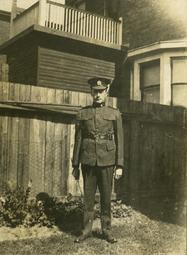
Unit
Royal Irish Rifles
Branch
Infantry
Service Component
British Expeditionary Force
Service Number
79152
birth
1883/12/11
Comber, County Down, Ireland
death
1918/03/21
Somme, France
grave
Pozieres British Cemetery, France, Panel 74 to 76
Gender
Male
Second Lieutenant Edmund De Wind was born in Comber, County Down, Northern Ireland on 11 December 1883. He was the youngest child and second son of Arthur Hughes De Wind, C.E., a civil engineer, and Margaret Jane (Stone) De Wind. He was educated at Campbell College, Belfast and later worked for the Bank of Ireland. He immigrated to Canada in 1911, arriving in Montreal aboard the SS Royal George on 10 November, and first lived in Toronto. While there, he spent six months serving with the Queen’s Own Rifles of Canada of the Canadian Militia. By the time the First World War broke out, he was living in Edmonton and working as a bank official with the Canadian Bank of Commerce (later the Canadian Imperial Bank of Commerce [CIBC]).
De Wind enlisted in the 31st Canadian Infantry Battalion in Edmonton, Alberta on 16 November 1914. After initial training in Canada, he sailed for England aboard the SS Lapland on 29 May 1915. He arrived in Boulogne, France on 19 September 1915 and would later attend a Lewis gun course at the divisional school in May 1916. He was transferred to the Alberta Regimental Depot in England on 20 March 1917 to attend cadet school, showing on command to No. 17 Officer Cadet Corps, Kimmel Park as of 6 June 1917. He was granted a commission in the British Army at the rank of Second Lieutenant on 25 September 1917 and was discharged from the Canadian Expeditionary Force at No. 2 Canadian Discharge Depot, London on the same day.
De Wind was serving as a Second Lieutenant with the 15th Battalion, The Royal Irish Rifles when the Germans launched their Spring Offensive (Operation Michael). On the first day of the offensive, 21 March 1918, he was stationed at the Race Course Redoubt near Gruiges, France when his position was overrun by enemy forces. Despite being wounded, he spent several hours repelling these attacks until receiving a mortal wound and dying the same day. His body was never recovered. He is commemorated on the Pozières Memorial in Pozières, France, as well as on page 586 of the First World War Book of Remembrance.
De Wind was posthumously awarded the Victoria Cross for his actions of 21 March 1918. His Victoria Cross was presented to his mother by King George V during a private ceremony at Buckingham Palace on 21 June 1919. Mount De Wind in Willmore Wilderness Park, Alberta is named in his honour.
Victoria Cross
“For most conspicuous bravery and self-sacrifice on the 21st March, 1918, at the Race Course Redoubt, near Grugies. For seven hours he held this most important post, and though twice wounded and practically single-handed, he maintained his position until another section could be got to his help. On two occasions, with two N.C.O.’s only, he got out on top under heavy machine-gun and rifle fire, and cleared the enemy out of the trench, killing many. He continued to repel attack after attack until he was mortally wounded and collapsed. His valour, self-sacrifice and example were of the highest order.”
- London Gazette, 13 May 1919, Supplement 31340



